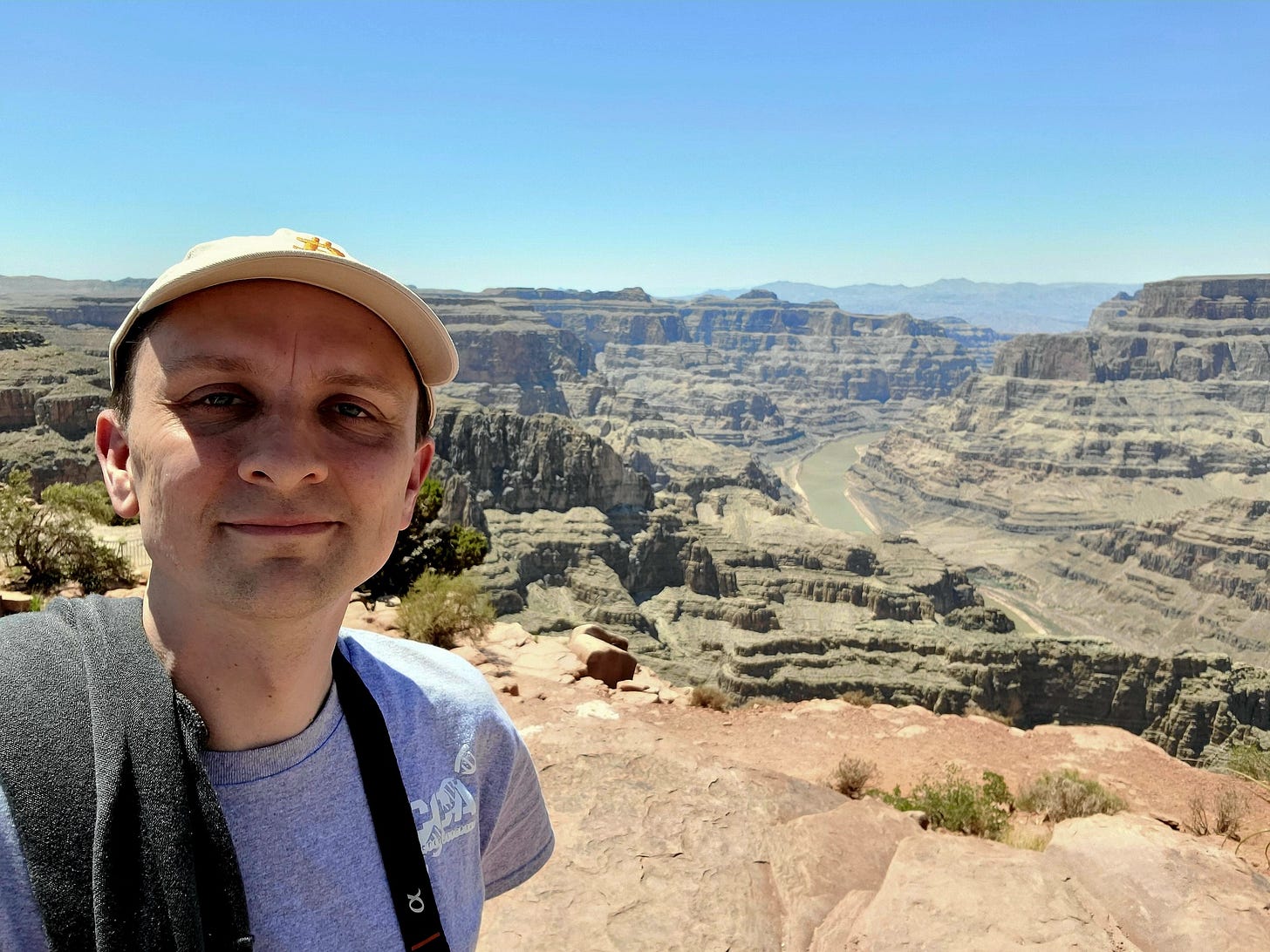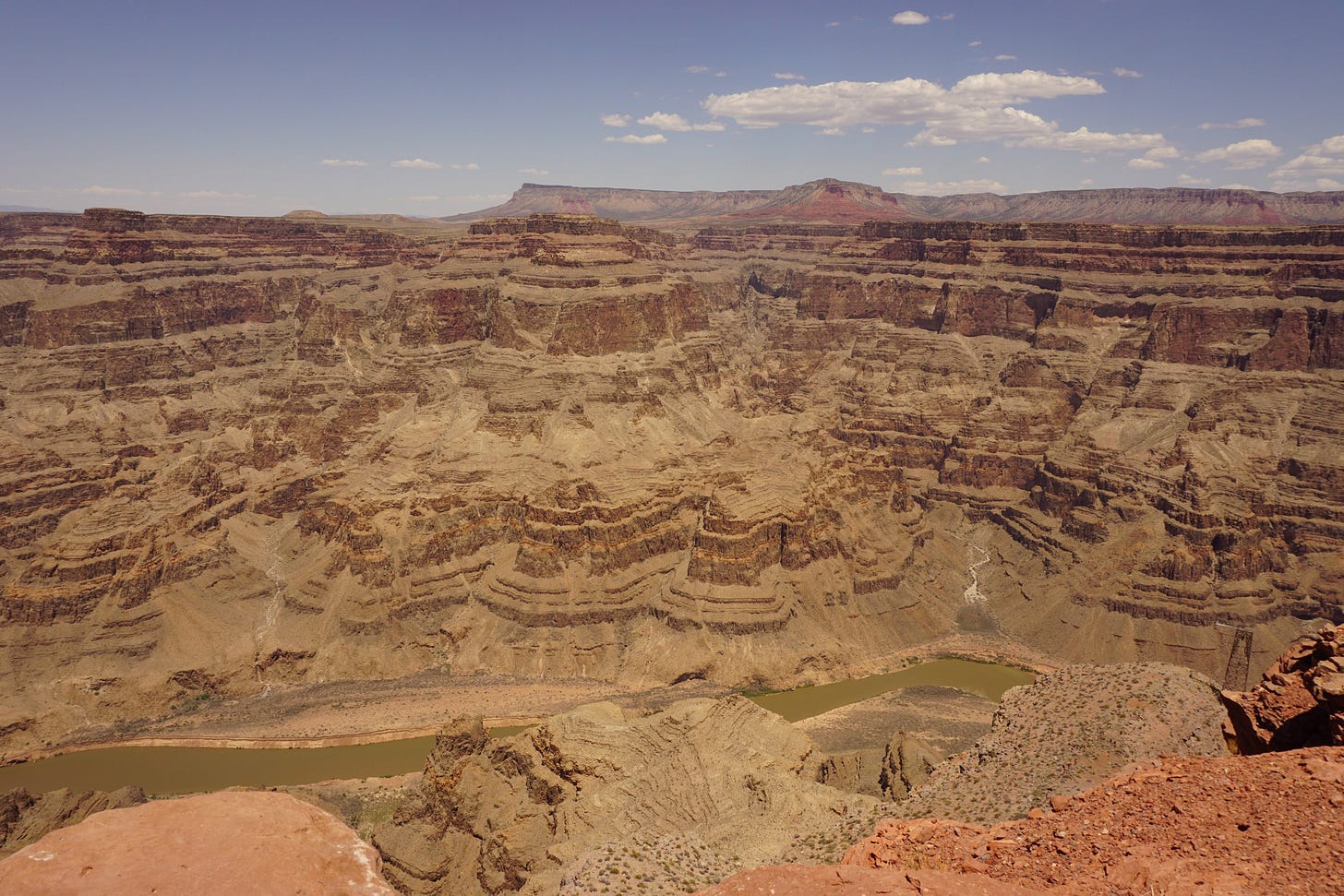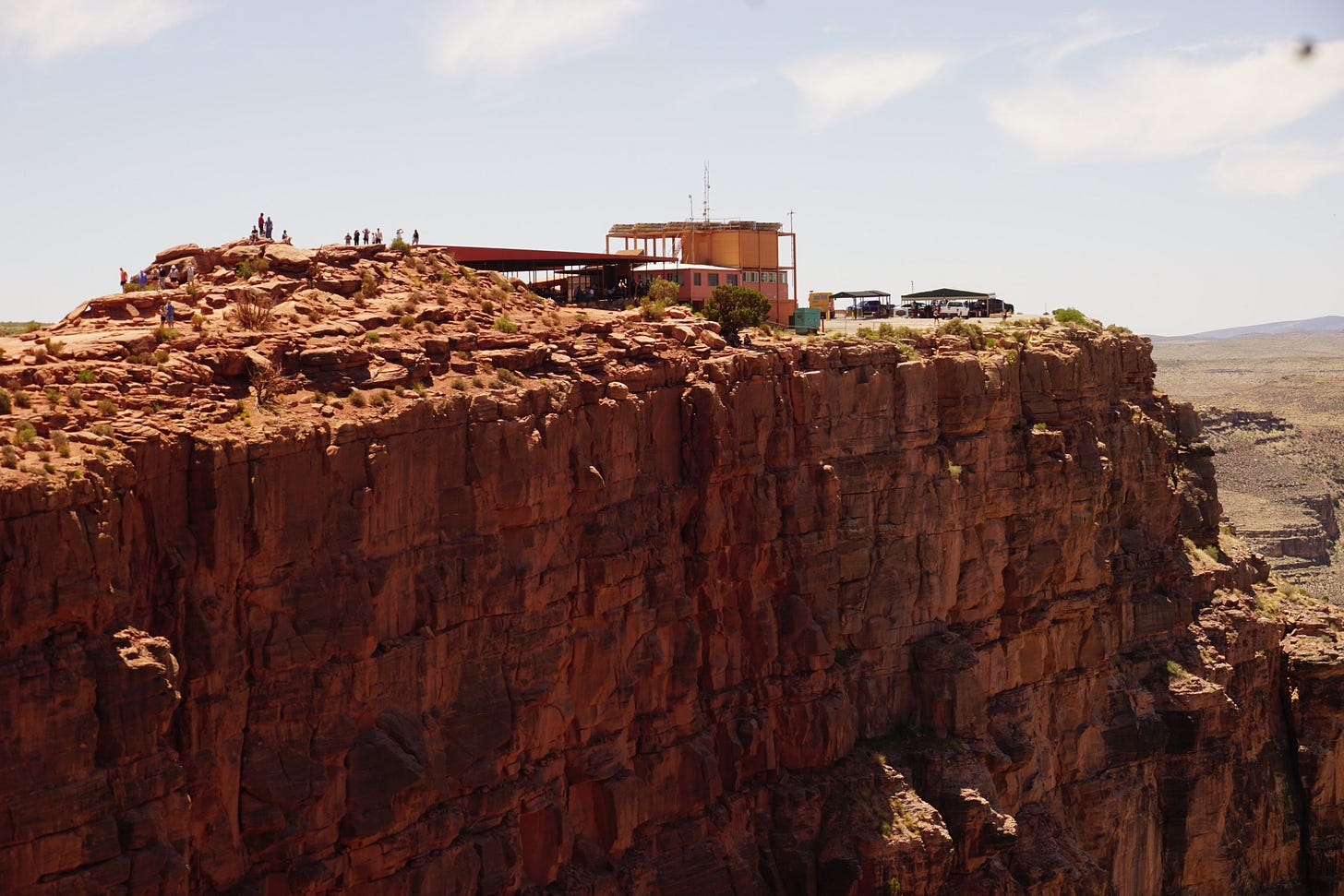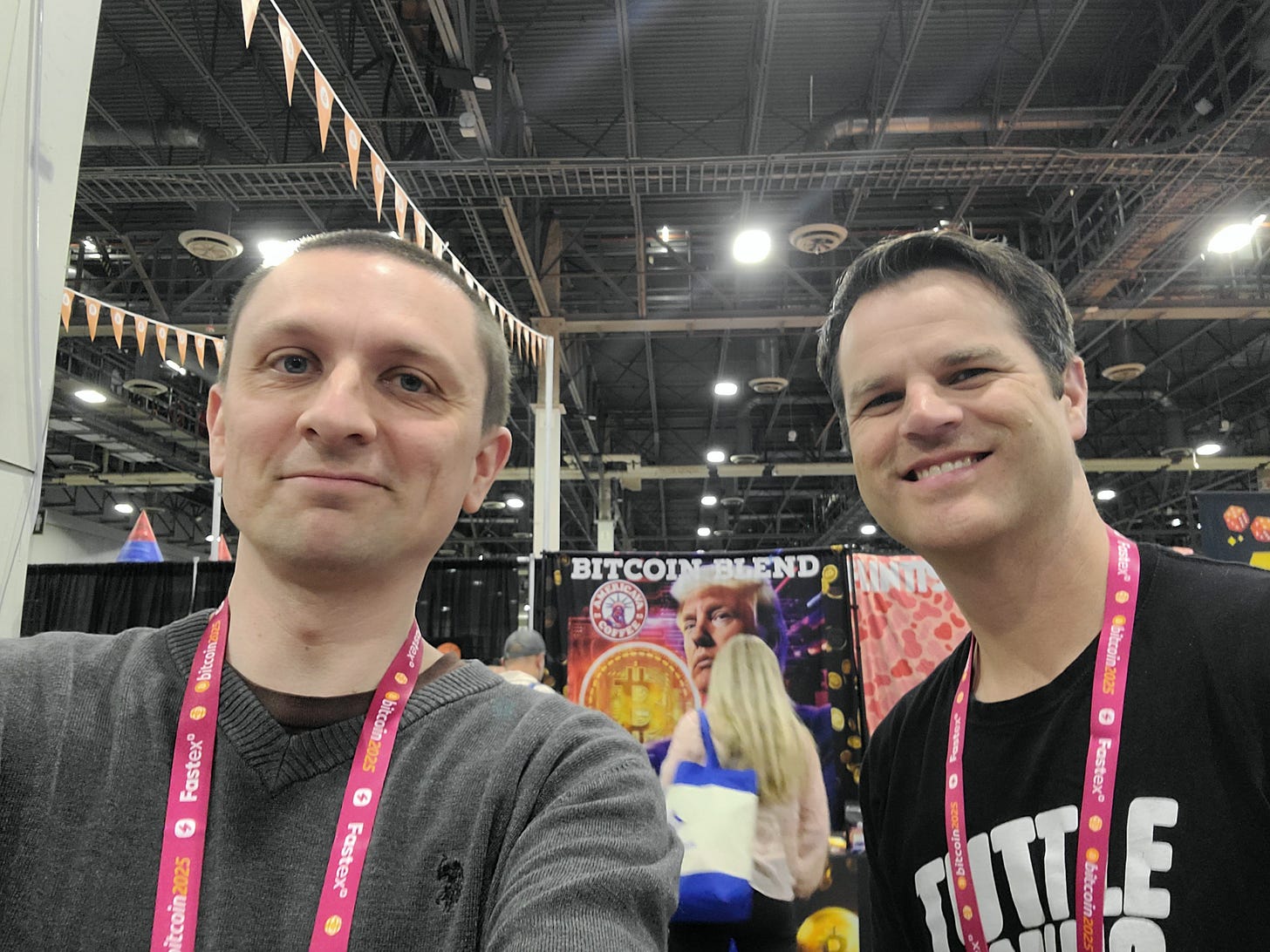Once upon a time in the West (last week, I mean)
Wide open spaces, popular poetry, nothing stops this train, meeting celebrities
I wanted to share a few more reflections from last week’s trip to Las Vegas / out West.
Wide open spaces
Last Friday I visited the Grand Canyon for the first time (West Rim).
It is quite a cut into the Earth, but it is difficult to get a sense of that in photos, I think in part because your eyes/brain don’t have anything “normal sized” to use as a comparison. If you look closely in this next photo, you can see a small red helicopter far below us, gives you some idea of scale (center bottom of the photo, a little above the river, three white rotors shaped like a “Y”).
And here is another nice canyon shot.
And here is a zoomed in photo of a visitor’s center, note also the people. I can now say that I’ve walked along a cliff edge with a several-thousand-feet drop (I did not see many, or perhaps any, kids walking around, I can tell you that). Our tour guide did mention that people fall to their deaths every year, often people trying to take funny photos where they pretend they’re about to fall, and then they actually fall. In a culture that has lifeguards monitoring a three foot deep public pool just in case, it is interesting that we also have places like this where you could just… walk right off the edge if you aren’t paying attention.
You have to compare that to living in Michigan a bit, of course. In Michigan, plant life appears on just about every exposed patch of soil (and also on things that aren’t soil) - come to Michigan to study biology, we have plenty of that. Maybe go to Arizona to learn geology, where you can actually see it. You can’t see a canyon like this, or myriad other exposed geology of the desert, and not wonder how they got that way.
(It’s kind of humorous to think… some homes in Las Vegas have plastic grass as their yard. If you tried a plastic grass yard in Michigan, it would start to grow moss, I think! You can’t get away from the plant life here.)
On the way to and from the Grand Canyon (from Las Vegas via bus), I was also struck by how much open space there was out there, and by the obvious poverty of many of the homes you did see. I suppose it might be more acceptable to be poor in the desert - if your roof is falling apart (as indeed, I saw many obviously damaged roofs), well it doesn’t actually have to keep away the water that often. Also I wondered about the abundance of nonfunctional automobiles sitting in yards - free to keep the broken car, but you have to pay for someone to take it away, I guess?
Our bus went through the town of Dolan Springs, Arizona, where the free-roaming cattle were an interesting concern for the bus driver. But our tour guide also said that 30% of the town has no running water at home, because they cannot afford to drill a well to get it (the median household income of the town is around $31,000 per year). So they come to a place in town and purchase water for 25 cents a gallon. I have seen that in Mexico, but didn’t know we still had places like that in the United States. Per that same Wikipedia page, the community has one ambulance to cover 2200 square miles, meaning ambulance response time (if it’s already busy at another call, far away) can be hours.
Popular poetry
A while back Anthony Esolen shared a list of ways our present society is an outlier in human history. They were: nobody sings, young people aren’t married, we don’t have enough children to replace ourselves, there is no truly popular poetry, we have almost no holy days, and we do not know our neighbors. Now, by “popular poetry”, I think he meant poems everyone knows and which sort of speak to our culture, not people going to poetry readings the way they go to the movies.
AND YET… at the Bitcoin Conference last week there was a poetry reading by IN-Q, which I’ll link to in just a moment. Now I don’t know this guy, maybe you do, but he read his poem before a group of about 20,000 people probably, who were obviously engaged and responding to the reading, in one of the highest profile time slots in the conference (between Michael Saylor and Ross Ulbricht). Is this popular poetry?
If you wanted Shakespeare, it’s not Shakespeare. But it made me think, and this goes for classical education, and liturgical reform movements, and other movements to “bring back” something valuable from the past - almost never are we just returning to the way things were before, nor would we want to, because the world has changed. What we are doing, in nearly all cases, is recognizing that there are valuable things in the tradition which have been largely forgotten, and we want to bring those back into our modern context. But we aren’t just going back to the way things were, we wouldn’t actually want that (however messed up you think 2025 to be, none of you would take a time machine trip back to 1850 permanently).
So, I don’t know if it really counts as “popular poetry”, but I enjoyed the poetry reading in person, so if you’d like, here’s a poem by IN-Q. They cut off the first couple of lines, so just know he’s talking about bitcoin (and criticizing “the system” generally). It gets better as he goes (I also cringed a little bit at “bitcoin is the truth”), but stick with it (should start at 07:52:30).
Nothing stops this train
Also at the Bitcoin Conference, there was a 20 minute talk by Lyn Alden, author of Broken Money and frequently interviewed on various financial podcasts. She has popularized this phrase, “nothing stops this train”, which I understand is originally from Breaking Bad, but I have not seen this show. To her, it means that the US federal government has an addiction to debt, we have a debt crisis, and nothing stops this train now. It doesn’t matter who you elect, what promises they make you, whatever, the US is in too deep now, nothing is going to stop the US debt from increasing without limit. So prepare yourself accordingly if you can (she likes gold and, of course, bitcoin).
In her talk, which you can watch in total if you’d like (and then ignore everything I write, if you do that), she shared a medley of charts, which I shall quickly summarize.
From about 1950 until 2017, the US unemployment rate, and the US federal deficit as a percentage of GDP, are very well correlated. During recessions, both go up, and during good times, both go down. But, starting around 2017, there was a decoupling. Unemployment at the time was trending down and has continued to go down (with the exception of a COVID-spike), but the federal deficit (as a percentage of GDP) began increasing and has continued to increase since then (with a super-spike during COVID).
From approximately 2006 to 2022, the price of gold, and (inverse) real interest rates are well correlated. And that makes sense - when the interest rate offered on US Treasury bills increases, people buy those instead of gold, and the gold price holds steady. When the interest rate offered on US Treasury bills decreases (falling below the inflation rate, say), they become less attractive, people buy gold instead, and the gold price rises. But, beginning around 2022, there has been a decoupling, with the interest rate on US Treasury bills increasing, but the price of gold also rather exploding at the same time. We seem to be in new territory now.
Most of the time, for the last 70 years, private sector debt growth has been larger than public sector debt growth (e.g. government debt), with brief exceptions that occur around recessions. But since 2008, public sector debt growth has been significantly larger than private sector debt growth regardless of how the economy is doing.
She shared a comparison between the interest rate on a 10-year US Treasury bill, and total US government debt. From about 1970 to 2020, interest rates generally declined, while total debt generally increased, but this combination meant that interest payments on the debt remained manageable. But around 2020, interest rates basically hit zero… they can’t go any lower than that. Now they’re climbing again, but climbing during a time in which the total debt is now huge, which is going to make interest payments on the debt soar.
The Social Security trust fund peaked in funds invested around 2020 (baby boomers paying into the system). It is now predicted to be bankrupt around 2035 (baby boomers withdrawing the money, with not enough new young people paying into the system). Young people protest, but old people actually vote - neither political party is interested in doing anything serious to fix this problem.
Ergo, nothing stops this train. She concludes with, in the coming years, we’ll be running large federal deficits regardless of what any politician says to you. Own high quality scarce assets to protect yourself.
Meeting celebrities
One final brief comment - there were many celebrities about at the Bitcoin Conference of course, many of them on stage. My brother in law asked me to shake Peter Schiff’s hand (hey, he’s a celebrity in some circles), which I did, but it was awkward - most of the people he talked to, I think, just wanted to poke fun at him. I didn’t, I actually like the guy, but he didn’t know that. I did also say hello to Tuttle Twins cartoon guy, Connor Boyack (yes, with Bitcoin Blend coffee in the background).
But what really struck me was, I passed the mayor of New York (Eric Adams) in a little hallway nook, taking a group photo with, I suspect, some constituents. And you know what, the guy is not that tall (really though, he is 5’8”). I’m joking but, you have that interaction even for just a second, and you realize… oh, he’s just a guy, like I’m just a guy. It sorts of breaks the mystique. I’ve said before that a good thing about the internet making sure we can all see, for example, photos of a socially awkward JD Vance in high school, is because now we can all see that the socially awkward guy next to you in high school could become vice president of the United States some day. That’s good to recognize. You’re a guy, he’s a guy.
That is all for now.






Just about everything that's not human is bigger once you get to the Rockies. Scales change; this is why I tend to scoff when people talk about, say, the mountains of New York.
Also, if you have the chance, I suggest someday driving through the non-urban part of any of the Southwest states for at least a couple hundred miles. Like the Grand Canyon, you can't grasp it from images on a screen. Even a bus doesn't give you the right viewpoint.